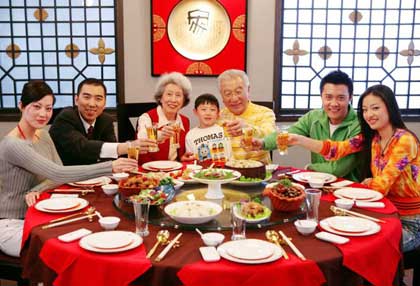Source: chinaculture.org
01-17-2008 17:12
 |
After the reunion dinner on New Year's Eve, or Chuxi in Chinese, it is the New Year! The menu for the first meal of the New Year is not a thorny problem for us Chinese. In northern China, dumplings are always the main dish on the dining table, while, in southern China, there is a wide variety of choices in difference provinces.
As one of the most important aspects of the Spring Festival, food is essential to a healthy, happy new year in Chinese tradition, and many dishes are imbued with auspicious and symbolic meanings either because of the appearance or the pronunciation of its Chinese name.
In Northern China, people usually eat jiaozi (dumplings), which first appeared in China some 1,600 years ago. The Chinese pronunciation of jiaozi means "midnight" or "the end and the beginning of time". Its crescent shape resembles that of ancient gold and silver ingots or a crescent moon which symbolizes the hope for a plentiful year. Sometimes, people stuff jiaozi with sugar for a "sweet" life, and others put one or two coins inside -- if you happen to come across a coin-stuffed jiaozi, you will have good luck.
But southerners like to eat nian gao, or "New Year Cake" -- a sweet sticky brown cake made of rice flour and sugar. In Chinese, gao is a homonym for "high", and nian is "year". Nian gao is a homonym for "higher each year" and symbolizes improvement in life year by year. Their sweetness symbolizes a rich sweet life. Finally, the round shape signifies family reunion.
A symbolic food for the Lantern Festival is small dumpling balls made of glutinous rice flour and filled with sweet stuffing. It is called yuan xiao or tang yuan. Round in shape, they symbolize family unity, completeness and happiness.
